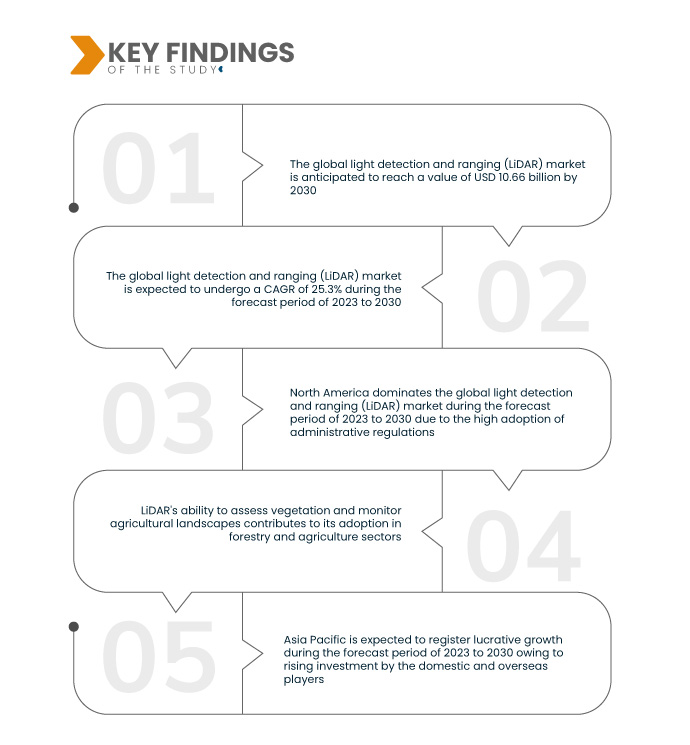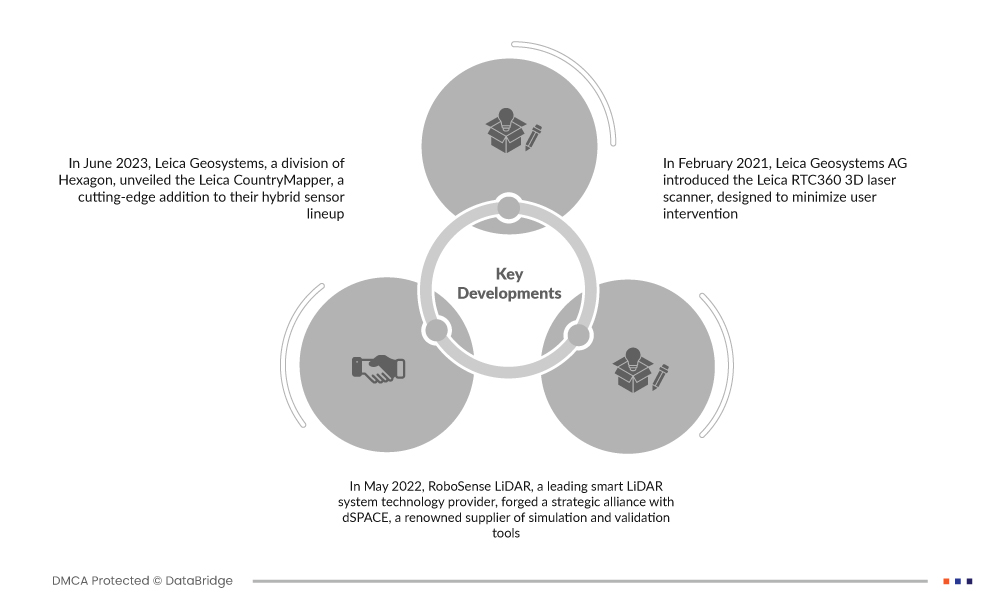The global light detection and ranging (LiDAR) market, propelled by technological advances, employs laser beams for precise 3D mapping. Widely used in autonomous vehicles for accurate navigation, it serves diverse applications in forestry, archaeology, and urban planning. Recognized for high accuracy, long-range capabilities, and real-time data capture, LiDAR facilitates industries in obtaining detailed spatial information for various purposes.
Access Full Report @ https://www.databridgemarketresearch.com/reports/global-lidar-market
Data Bridge Market Research analyses that the Global Light Detection and Ranging (LiDAR) Market which was USD 1.75 billion in 2022, is expected to reach USD 10.66 billion by 2030, and is expected to undergo a CAGR of 25.3% during the forecast period of 2023 to 2030. Increasing adoption of mid- and high-degree precision GPS receivers in the construction industry, particularly in large-scale projects such as megaprojects for civil construction sites, is a significant driver for the growth of the light detection and ranging (LiDAR) market. This integration enhances accuracy and efficiency in construction operations, fueling LiDAR's demand.
Key Findings of the Study
Real-time data capture is expected to drive the market's growth rate
LiDAR stands out in industries demanding dynamic and up-to-date information due to its remarkable capability for high-quality spatial data capture in real time. This feature is particularly crucial in scenarios where instantaneous and accurate data is essential, ranging from autonomous vehicle navigation to dynamic environmental monitoring. The real-time capabilities of LiDAR contribute significantly to its versatility and effectiveness across a spectrum of applications, ensuring industries stay well-informed and responsive to changing conditions.
Report Scope and Market Segmentation
|
Report Metric
|
Details
|
|
Forecast Period
|
2023 to 2030
|
|
Base Year
|
2022
|
|
Historic Years
|
2021 (Customizable to 2015-2020)
|
|
Quantitative Units
|
Revenue in USD Billion, Volumes in Units, Pricing in USD
|
|
Segments Covered
|
Component (Laser Scanners, Navigation and Positioning Systems, Others), Technology (2D LiDAR, 3D LiDAR, 4D LiDAR), Type (Mechanical, Solid-State), Installation Type (Airborne LiDAR, Ground-Based LiDAR), Range (Short, Medium, Long), Service (LiDAR Data Processing, Aerial Surveying, Asset Management, GIS Service, Ground-Based Surveying, Mapping and Modelling, Others), Application (Corridor Mapping, Engineering, Environment, ADAS and Driverless Cars, Exploration, Urban Planning, Cartography, Meteorology), End User (Defense and Aerospace, Civil Engineering, Archaeology, Forestry and Agriculture, Mining Industry, Transportation)
|
|
Countries Covered
|
U.S., Canada, Mexico, Brazil, Argentina, Rest of South America, Germany, Italy, U.K., France, Spain, Netherlands, Belgium, Switzerland, Turkey, Russia, Rest of Europe, Japan, China, India, South Korea, Australia, Singapore, Malaysia, Thailand, Indonesia, Philippines, Rest of Asia-Pacific, Saudi Arabia, U.A.E., South Africa, Egypt, Israel, and Rest of Middle East and Africa
|
|
Market Players Covered
|
Trimble Inc. (U.S.), Leica Geosystems AG (Switzerland), Teledyne Optech (Canada), FARO (U.S.), SICK AG (Germany), NV5 Global, Inc. (U.S.), SureStar (China), Velodyne Lidar, Inc. (U.S.), YELLOWSCAN (France), GeoKno (India), Phoenix LiDAR Systems (U.S.), LeddarTech Inc. (Canada), Quanergy Systems, Inc. (U.S.), Innoviz Technologies Ltd. (Israel), ZX Lidars (U.K.), Vaisala (Finland), Waymo LLC (U.S.), Valeo (U.S.), and Ouster, Inc. (U.S.)
|
|
Data Points Covered in the Report
|
In addition to the insights on market scenarios such as market value, growth rate, segmentation, geographical coverage, and major players, the market reports curated by the Data Bridge Market Research also include in-depth expert analysis, geographically represented company-wise production and capacity, network layouts of distributors and partners, detailed and updated price trend analysis and deficit analysis of supply chain and demand.
|
Segment Analysis:
The global light detection and ranging (LiDAR) market is segmented on the basis of component, technology, type, installation type, range, service, application and end user.
- On the basis of components, the global light detection and ranging (LiDAR) market is segmented into laser scanners, navigation and positioning systems, and others
- On the basis of technology, the market is segmented into 2D LiDAR, 3D LiDAR, and 4D LiDAR
- On the basis of type, the global light detection and ranging (LiDAR) market is segmented into mechanical, and solid-state
- On the basis of installation type, the global light detection and ranging (LiDAR) market is segmented into airborne LiDAR, and ground-based LiDAR
- On the basis of range, the global light detection and ranging (LiDAR) market is segmented into short, medium, and long
- On the basis of service, the global light detection and ranging (LiDAR) market is segmented into LiDAR data processing, aerial surveying, asset management, gas service, ground-based surveying, mapping and modelling, and others
- On the basis of application, the global light detection and ranging (LiDAR) market is segmented into corridor mapping, engineering, environment, adas and driverless cars, exploration, urban planning, cartography, and meteorology
- On the basis of end user, the global light detection and ranging (LiDAR) market is segmented into defense and aerospace, civil engineering, archaeology, forestry and agriculture, mining industry, and transportation
Major Players
Data Bridge Market Research recognizes the following companies as the major global light detection and ranging (LiDAR) market players in global light detection and ranging (LiDAR) market are GeoKno (India), Phoenix LiDAR Systems (U.S.), LeddarTech Inc. (Canada), Quanergy Systems, Inc. (U.S.), Innoviz Technologies Ltd. (Israel), ZX Lidars (U.K.), Vaisala (Finland), Waymo LLC (U.S.), Valeo (U.S.), and Ouster, Inc. (U.S.)
Market Developments
- In June 2023, Leica Geosystems, a division of Hexagon, unveiled the Leica CountryMapper, a cutting-edge addition to their hybrid sensor lineup. This innovative solution seamlessly integrates a large-format photogrammetric camera with a high-performance LiDAR unit into a single system. The CountryMapper excels in efficiently capturing large-area images and conducting LiDAR mapping simultaneously. This integration empowers the generation of highly accurate geospatial data, catering to diverse customer applications with precision and versatility
- In May 2022, RoboSense LiDAR, a leading smart LiDAR system technology provider, forged a strategic alliance with dSPACE, a renowned supplier of simulation and validation tools. This partnership aims to accelerate the development, testing, and validation of LiDAR in intelligent driving applications. As part of the partnership, multiple RoboSense LiDAR sensors will be integrated into the dSPACE simulation and validation toolchain, enhancing the capabilities of both entities in advancing technologies for the evolving landscape of autonomous driving
- In February 2021, Leica Geosystems AG introduced the Leica RTC360 3D laser scanner, designed to minimize user intervention. This innovative scanner is geared towards enhancing productivity, flexibility, and scanning efficiency in reality capture projects. With advanced features, it reduces the need for constant user monitoring, offering a streamlined solution for professionals engaged in tasks requiring precise and efficient 3D laser scanning, marking a notable advancement in geospatial technology
Regional Analysis
Geographically, the countries covered in the global light detection and ranging (LiDAR) market report are U.S., Canada, Mexico, Brazil, Argentina, Rest of South America, Germany, Italy, U.K., France, Spain, Netherlands, Belgium, Switzerland, Turkey, Russia, Rest of Europe, Japan, China, India, South Korea, Australia, Singapore, Malaysia, Thailand, Indonesia, Philippines, Rest of Asia-Pacific, Saudi Arabia, U.A.E., South Africa, Egypt, Israel, and Rest of Middle East and Africa
As per Data Bridge Market Research analysis:
North America is the dominant region in the global light detection and ranging (LiDAR) market during the forecast period 2023-2030
North America dominates the global light detection and ranging (LiDAR) market, driven by the widespread adoption of administrative regulations and mandates for integrating automotive safety technologies in both lightweight and heavyweight vehicles. The region's commitment to enhancing safety standards has propelled the demand for LiDAR, positioning it as a critical component in the automotive sector. The regulatory environment and emphasis on safety measures continue to foster the market's growth, making North America a key player in advancing LiDAR technology.
Asia-Pacific is estimated to be the fastest-growing region in the global light detection and ranging (LiDAR) market during the forecast period 2023-2030
Asia-Pacific is expected to dominate the global light detection and ranging (LiDAR) market from 2023 to 2030. The region anticipates substantial growth, fueled by increased investments from both domestic and overseas players, particularly in countries such as China and India. This surge in investment underscores the strategic importance of Asia-Pacific in driving advancements and applications of LiDAR technology, positioning the region as a key player in the evolving landscape of geospatial mapping and related industries.
For more detailed information about the global light detection and ranging (LiDAR) market report, click here – https://www.databridgemarketresearch.com/reports/global-lidar-market
















